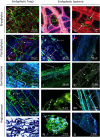The Hidden World within Plants: Ecological and Evolutionary Considerations for Defining Functioning of Microbial Endophytes
- PMID: 26136581
- PMCID: PMC4488371
- DOI: 10.1128/MMBR.00050-14
The Hidden World within Plants: Ecological and Evolutionary Considerations for Defining Functioning of Microbial Endophytes
Abstract
All plants are inhabited internally by diverse microbial communities comprising bacterial, archaeal, fungal, and protistic taxa. These microorganisms showing endophytic lifestyles play crucial roles in plant development, growth, fitness, and diversification. The increasing awareness of and information on endophytes provide insight into the complexity of the plant microbiome. The nature of plant-endophyte interactions ranges from mutualism to pathogenicity. This depends on a set of abiotic and biotic factors, including the genotypes of plants and microbes, environmental conditions, and the dynamic network of interactions within the plant biome. In this review, we address the concept of endophytism, considering the latest insights into evolution, plant ecosystem functioning, and multipartite interactions.
Copyright © 2015, American Society for Microbiology. All Rights Reserved.
Figures



References
Publication types
MeSH terms
Substances
Grants and funding
LinkOut - more resources
Full Text Sources
Other Literature Sources

